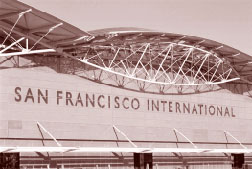Learning From SFO

As we strolled, a colleague remarked that he is intrigued by parallels between the structure of architects’ practices and the forms of their buildings. In the case of the IT, one such parallel is striking: this simple, understandable-at-a-glance space was designed by three architectural firms (Skidmore, Owings & Merrill, Michael Willis Architects and Del Campo & Maru) who collaborated not from separate offices, but instead by sharing a single, understandable-at-a-glance space. No doubt other factors abetted the success of the collaboration—for example, the three firms formed teams for various tasks by pooling their talents without regard for firm affiliation—but we are gratified to note the impact of space on the formation of a design team.
The strategy has worked before. As Environmental Design Manager for the 1984 Olympic Games in Los Angeles, David Meckel, FAIA (and AIACC’s V.P. of Communications), convinced the Olympic Committee to rent a 60,000 square foot warehouse space, then required all the firms designing buildings for the Games to set up project offices there. At the end of each day, all the work went up on the walls. As Meckel explains, L.A. is not Munich, so a method other than top-down control was needed to prompt consistent design quality.
Sometimes it is good to put everybody or everything in one room; other times it’s not. Those of us who frequent SFO are united in our admiration for its remarkable exhibitions program, a museum not defined by walls, but dispersed throughout the airport. We asked Curator-in-Charge John Hill if he could compare the scale of the SFO program with those of conventional museums. Allowing that the numbers are impossible to confirm, he was nevertheless willing to estimate: 42 million passengers/year plus two to three greeters per passenger: say, conservatively, 120 million visitors per year (including 30,000 airport employees). If you figure that one person in ten pays attention to an exhibit, you have an “attendance” at SFO second, nationally, only to the Air and Space Museum.
We are accordingly unconvinced of the “crisis in public space,” and retain some faith that the disposition of spaces, their consolidation or diffusion—or, to put it plainly, where we put walls and where we don‘t—still makes a difference in public experience.
Two other reasons to say “we”: first, Therese Bissell, the outgoing editor of arcCA, whom I am privileged to succeed, lent a helpful hand in editing the articles for this issue. Thank you, Terry. Second, arcCA is blessed with a frisky and acute editorial board (check out the masthead), who collectively shape its content.
We hope you enjoy “Common Ground.”
Photo by Alain McLaughlin.
Originally published late 2000, in arcCA 00.2, “Common Ground.”





